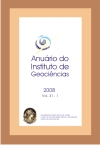Composition of the stratiform stromatolites of lagoa Salgada, Rio de Janeiro, Brazil
DOI:
https://doi.org/10.11137/2008_2_42-49Abstract
Lagoa Salgada is situated in the north coast of State of Rio de Janeiro, between the districts of Campos dos Goitacazes and São João da Barra, some 41º00'30" W and 21º54'10"S. In the margins of the lagoon the presence of recent stromatolitic constructions was verified. The stromatolite may be defined as lithifying biosedimentary structure, growing through of sediment blade trapping by the carbonate precipitation as result of microbian organism activity. The aim of this study was to characterize the cyanobacteria assemblage in stratiform stromatolites found on the floor of lagoa Salgada. Within the stratiform stromatolites 21 species of cyanobacteria were found, Microcoleus chthonoplastes (Thuret) Gomont 1892 and Lyngbya aestuarii (Liebman) Gomont 1892 are frequent in these stromatolites. The presence of calcite was observed in the stratiform stromatolites. The filamentous cyanobacteria are responsible for the union and imprisonment of sediment to form the layers in the stromatolites. The skeleton remains of mollusks, foraminifers and ostracod found in the area, work as a source of calcium carbonate and of sediment to structure the stromatolitesDownloads
Download data is not yet available.
Downloads
Published
2008-12-01
How to Cite
Silva, L. H. da S. e, Iespa, A. A. C. and Iespa, C. M. D. (2008) “Composition of the stratiform stromatolites of lagoa Salgada, Rio de Janeiro, Brazil”, Anuário do Instituto de Geociências. Rio de Janeiro, BR, 31(2), pp. 42–49. doi: 10.11137/2008_2_42-49.
Issue
Section
não definida
License
This journal is licensed under a Creative Commons — Attribution 4.0 International — CC BY 4.0, which permits use, distribution and reproduction in any medium, provided the original work is properly cited.















